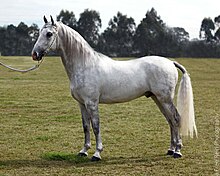
Back ليبيزان Arabic Lipizzano AST Lipizan atı Azerbaijani Lipicaner BS Cavall lipizzà Catalan Lipicán Czech Липица лаши CV Lipizzaner German Lipica ĉevalo Esperanto Lipizzano Spanish
 A modern Lipizzan | |
| Other names | Lipizzaner, Karster |
|---|---|
| Country of origin | Developed by the House of Habsburg from Arab, Barb, Spanish and Neapolitan stock.[1] Today associated with the nations of Austria, Bosnia and Herzegovina, Croatia, Hungary, and Slovenia. |
| Traits | |
| Distinguishing features | Compact, muscular, mostly but not exclusively gray in color, popularly associated with the Spanish Riding School. |
| Breed standards | |
The Lipizzan or Lipizzaner (Croatian: Lipicanac, Czech: Lipicán, German: Lipizzaner, Hungarian: Lipicai, Italian: Lipizzano, Serbian: Lipicaner, Slovene: Lipicanec) is a European breed of riding horse developed in the Habsburg Empire in the sixteenth century. It is of Baroque type, and is powerful, slow to mature and long-lived; the coat is usually gray.
The name of the breed derives from that of the village of Lipica (Italian: Lipizza), which was part of the Habsburg empire at the time the breed was developed, now in Slovenia, one of the earliest stud farms established; the stud farm there is still active. The breed has been endangered numerous times by warfare sweeping Europe, including during the War of the First Coalition, World War I, and World War II. The rescue of the Lipizzans during World War II by American troops was made famous by the Disney movie Miracle of the White Stallions.
The Lipizzaner is closely associated with the Spanish Riding School of Vienna, Austria, where the horses demonstrate the haute école or "high school" movements of classical dressage, including the highly controlled, stylized jumps and other movements known as the "airs above the ground". These horses are mostly bred at the Piber Federal Stud, near Graz, Austria, and are trained using traditional methods of classical dressage that date back hundreds of years.
Eight stallions are recognized as the classic foundation bloodstock of the breed, all foaled in the late eighteenth and early nineteenth centuries. All modern Lipizzans trace their bloodlines to these eight stallions, and all breeding stallions have included in their name the name of the foundation sire of their bloodline. Also classic mare lines are known, with up to 35 recognized by various breed registries. The majority of horses are registered through the member organizations of the Lipizzan International Federation, which covers almost 11,000 horses in 19 countries and at 9 state studs in Europe. Most Lipizzans reside in Europe, with smaller numbers in the Americas, South Africa, and Australia.
Lipizzan horse breeding traditions are recognized by UNESCO and inscribed on the Representative List of the Intangible Cultural Heritage of Humanity.
- ^ Das K.K. Hofgestüt zu Lippiza 1580–1880, Wien 1880
© MMXXIII Rich X Search. We shall prevail. All rights reserved. Rich X Search